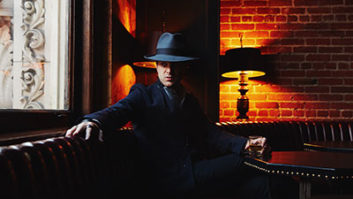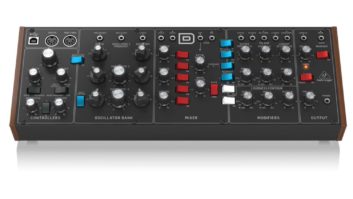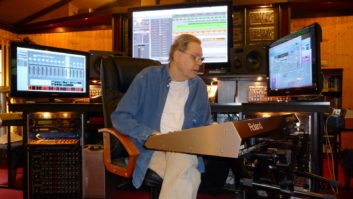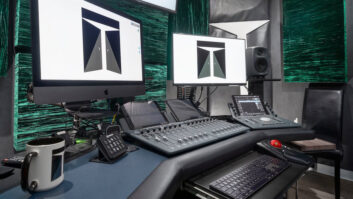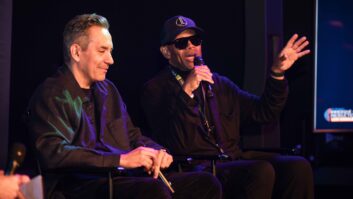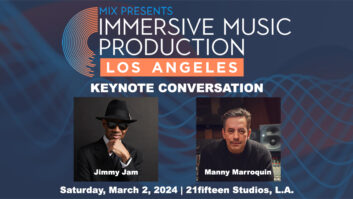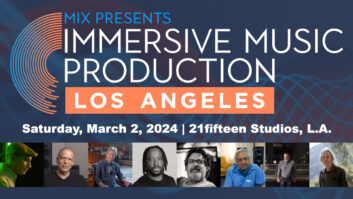On the outside, Craig Leon seems to glide effortlessly across his musical adventures. The expanse of his creative accomplishments is startling, ranging from early production work with The Ramones, Richard Hell and Blondie, to his orchestration and recording projects with Luciano Pavarotti and The London Symphony Orchestra, to his early experiments with quad recording and immersive audio.
However, Leon’s true passion is evident in his own recordings, where he is pushing the boundaries of contemporary electronic music. His newest album, Anthology of Interplanetary Folk Music Vol. 2: The Canon, is the latest in a multi-decade project that finds the artist combining unique synthesizer-based compositions with astounding dynamic visual elements. Pro Sound News caught up with Leon after a commanding performance at Moogfest 2019.
On folk roots
 Basically, the album was projected as a series and it was supposed to parallel an American compilation from the ’50s that was very important. This four-record set, called The Anthology of American Folk Music, was put together by a fellow named Harry Smith around 1951, when he collected all of this American heritage music. He put it together in such a way that people were not supposed to be prejudiced against each other anymore when they heard it and become more tolerant. Eventually it became the role model for all of the folk singers; they learned their repertoire from that in the 1950s and ’60s and eventually became the protest writers who were politically motivated: Bob Dylan, Joan Baez, Roger McGuinn—just about anyone who got started in folk.
Basically, the album was projected as a series and it was supposed to parallel an American compilation from the ’50s that was very important. This four-record set, called The Anthology of American Folk Music, was put together by a fellow named Harry Smith around 1951, when he collected all of this American heritage music. He put it together in such a way that people were not supposed to be prejudiced against each other anymore when they heard it and become more tolerant. Eventually it became the role model for all of the folk singers; they learned their repertoire from that in the 1950s and ’60s and eventually became the protest writers who were politically motivated: Bob Dylan, Joan Baez, Roger McGuinn—just about anyone who got started in folk.
On interstellar inspiration
My first album came from a fairy I got from an art exhibit of a tribe in Africa. Over thousands of years, this tribe’s entire output has been pictures of beings from another planet that came down from space, taught them about civilization and gave them their religion—these things were called the Nommos. So when I started this recording, I wanted to parallel Harry Smith—I wanted to do the Anthology of Interplanetary Folk Music, to include my theories about the folk music of the visitors from another planet. So I created a mathematical system and a musical system to try to portray that, and it was planned to be a three or four album set. The Canon carries this on and takes the listener on a journey through a fictional story on the teachings of the Nommos into our society.
On using synths
In classical, you have a set of rules that you can’t avoid. You can’t make a clarinet play lower than it can play without moving to a larger member of the family, to an alto or a bass clarinet if you need it. And you can’t make it go higher than the person playing it can manage without killing himself. So ultimately, you are constrained by the physicality of what those instruments can do. With synths, you have a much wider representation. Synths grew out of electronic organs and Theremins, and electronically, they were supposed to recreate orchestras but ended up having a sound of their own. With synths, there are an infinite variety of sounds you can achieve, and if you use many synths, like I do, each one has a different characteristic that you can blend to make your own individual sound. My choice of instruments is a bit more instinctual now because I kind of know what these instruments are capable of. And I mean ‘kind of’ because you learn something new every day.
On tracking and mixing
I love my Pyramix system, which is totally digital. But I use this tool in an analog way—I hit play and record, then I play. I was first introduced to Pyramix because it became the standard for classical recording in Europe, and it still is. It is great for editing, as good as anything in my opinion. Also you can get 200 tracks at 192 kHz if you want—it can go as big as your computer can handle. What you don’t get is the variable tape speed that we had on Nommos because the machine was worn out! As for the mixing, a lot of the effects, echoes and delays you are hearing are inherent in the original sounds, so it is mostly a question of placement. Most of the effects are already printed, and luckily, I have enough tracks so I print them on many tracks—so the stems are available if I want to work in immersive audio. All in all, in terms of mixing, I might do 40, 50 passes and spend about five or six days max.
On recording The Ramones’ first album

There were a lot of rehearsals involved with The Ramones in the studio, because they were very raw live. When I first saw them, it was like one big blur all the way through, kind of like Can’s Monster Movie (Made in a Castle with Better Equipment) but played at 300 miles an hour! Tommy [Ramone] was meticulous and would play to a visual metronome. He would watch it like a hawk it in front of his drum kit while playing at 180 bpm or whatever it was.
On the reissue, we did the mono mix, but back in the day, the record company suit guys said that “Mono is old fashioned,” but I had all the notes to do it and the original rough draft mono mixes were in the vaults at Warner—so when it came time to do the reissue, we did it in mono! One of the funniest things about that record was that Dee Dee [Ramone] counted in each song live at the beginning with the mic feeding back. But he counts “1,2,3,4!” in the same rhythm and the same BPM every time, even if the song itself has a different rhythm! It was his trademark, and it had absolutely nothing to do with what is going on in the song after it.
Jacques Sonyieux is a devout explorer of recording studios and the artists that occasionally inhabit them.

